
A rapidly-intensifying winter storm continues to bring heavy snow, high winds, and blizzard conditions over the Upper Midwest and Great Lakes through today. An Arctic front will lead in a period of gusty to high winds and sharply colder temperatures over the entire eastern U.S. Heavy lake effect snow is then expected from Lakes Erie and Ontario through New Year's Day. Read More >
This virtual tour will bring you on a journey of what it takes to prepare and launch an upper-air atmospheric sounding, but first a little bit of information and history. The National Weather Service weather forecast office (WFO) located in Reno, NV is a participant in the world-wide atmospheric sounding program. There are currently more than 800 radiosonde sites worldwide, with the United States/National Weather Service running or supporting 92 sites in North America and the Pacific region, and another 10 sites in the Caribbean.
The program allows for a time synched upper atmospheric “snapshot” across the entire globe as soundings are typically launched at a specified time. These worldwide soundings are then ingested into the various global and synoptic scale forecast models as a main source of information for the various forecast models to initialize off of and produce forecasts for meteorologists and various other users. These soundings are also used extensively as a real-time data source as well, as the information can be plotted on various thermodynamic diagrams such as Skew-T log-P Diagrams and Stuve Diagrams providing valuable information to meteorologists. Atmospheric soundings are also used extensively for air pollution models and climate research. For more information about the history of upper-air observations please click here: History of Upper-Air Observations.
Map of CONUS Upper-Air Observing Stations
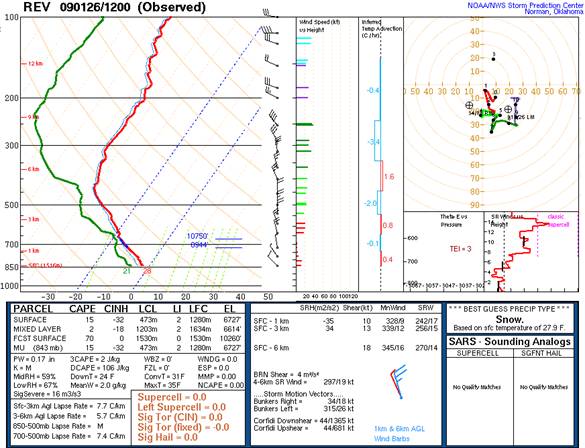
SkewT log-P Diagram with additional sounding data and calculations
Courtesy: NOAA/NWS - Storm Prediction Center
Across the entire planet twice a day at midnight and noon Zulu time ( Greenwich, England), weather balloons with radiosondes attached under them are launched to sample the global atmosphere. For NWS WFO Reno our weather balloons and radiosondes are launched at 4am and 4pm Pacific daylight savings time and at 3am and 3pm Pacific standard time. These flights are launched in all weather conditions ranging from blizzard conditions to high wind to temperatures over 100 degrees 365 days a year including weekends and holidays. The only real exception or delay of a flight would be when convective activity, like a thunderstorm, is present over or near the weather station. It is also important to note that “Special” soundings may be flown for various reasons which can include research, or when rapidly changing conditions are present in the atmosphere, or when severe weather is expected in a region.
Now, for the virtual tour portion of how the National Weather Service prepares and launches an atmospheric sounding. First we begin by gathering our supplies for the launch.
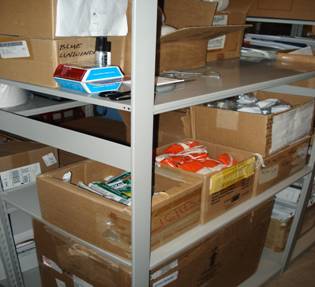
Storage Room
Each flight utilizes a weather balloon or sounding balloon which is a large specially made latex balloon which is designed to carry the instrument aloft in upwards of 90,000-100,000 feet! On the surface prior to launch the balloon is roughly 6 feet wide, and when the balloon reaches its termination level, the balloon can be larger than a 2-car garage. This is because as the balloon ascends through the atmosphere, pressure decreases, thus, allowing the balloon to grow larger and larger the higher the balloon ascends.
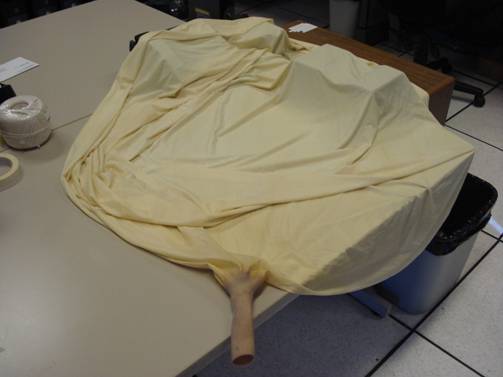
Standard National Weather Service Weather Balloon Pre-inflation
Next we have the instrument (radiosonde) which measures the pressure, temperature, and humidity. The wind speed and wind direction are also measured by either a radio direction finding antenna or using the satellite based Global Positioning System (GPS). WFO Reno just recently went through the Radiosonde Replacement System upgrade and uses GPS based radiosondes.
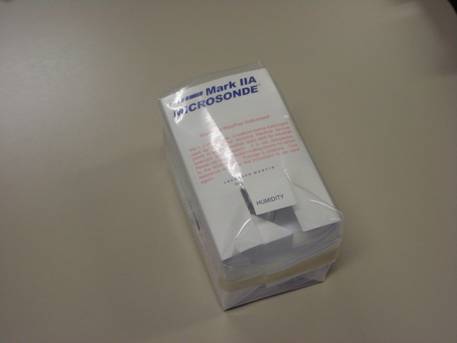
Mark IIA Radiosonde with GPS Receiver
The sounding train also includes a biodegradable parachute that deploys as the radiosonde returns to Earth after bursting at termination. Without it, the returning radiosonde could pose a danger to people or property since it weighs roughly one pound. The radiosonde will typically land well over 100 miles from the launching station.
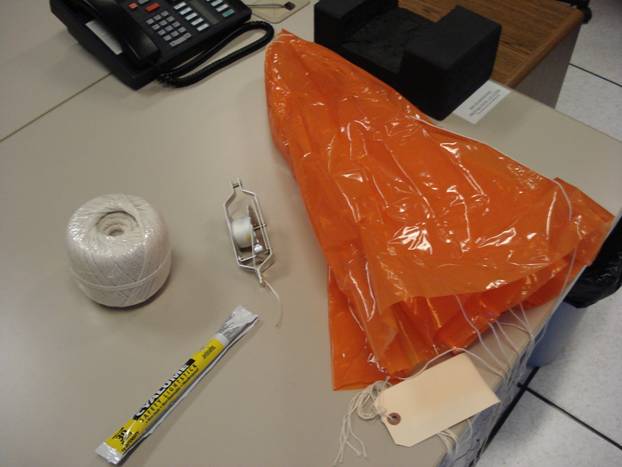
Upper-Air Supplies – Twine, Chemlight, Train Regulator, and a Parachute
On the 12z ( 3am or 4am depending on season) a non-hazardous chemlight is attached to the sounding train to help aid in visibility. This is particularly helpful for aircraft.
During launches where high winds are present, a special radiosonde train regulator is used to help aid the observer with the launch. As the weather balloon ascends through the atmosphere, the radiosonde train regulator unwinds and slowly increases the train length to the desired length for the sounding, which is typical 80 – 120 feet.
Once all the needed supplies are gathered for the flight, the observer will turn on and power up the Radiosonde Replacement System (RRS). This is typically done one hour before launch time, or even earlier if cold weather conditions are present. The RRS consists of the observing computer, an antenna which is housed in a radome, a remote unit for controlling the antenna, and a surface based observing weather system.
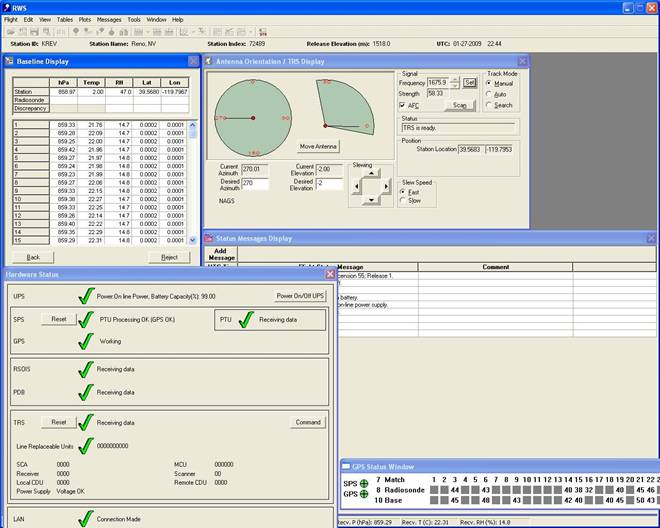
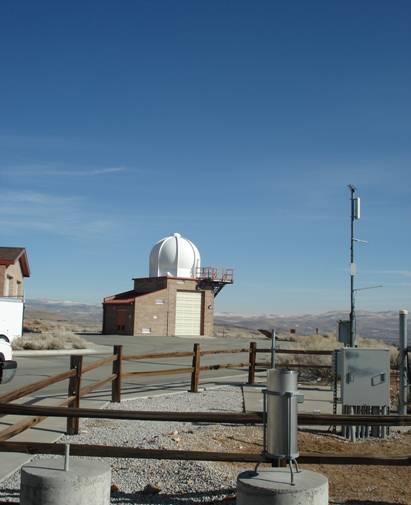
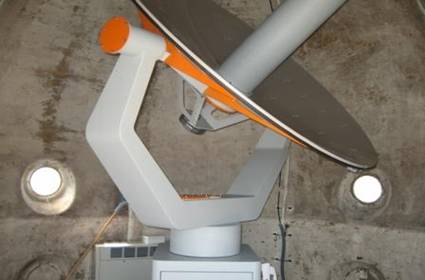
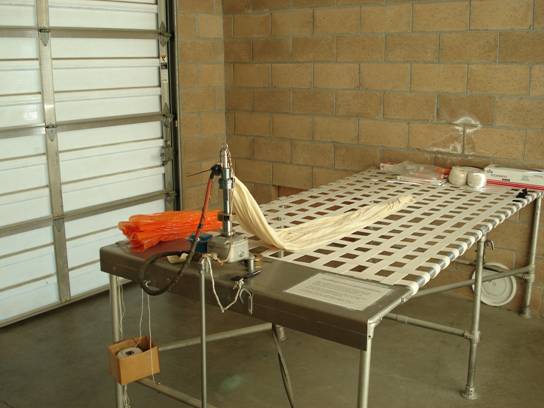
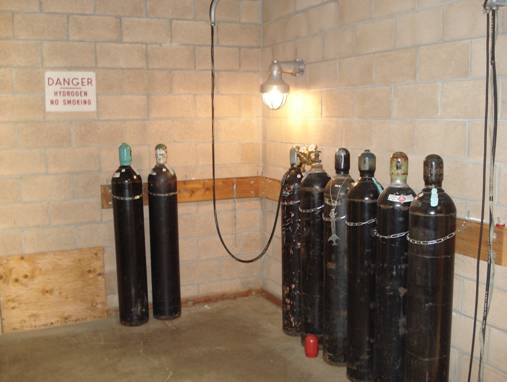
The observer must calculate the appropriate amount of lift for each sounding depending on the surface and atmospheric conditions present. This is achieved by using a weight system in order to attain the desired 5.0 m/s for the ascent rate. When high winds or precipitation are present more lift (hydrogen gas) will be added to the weather balloon in order to achieve the desired ascent rate.
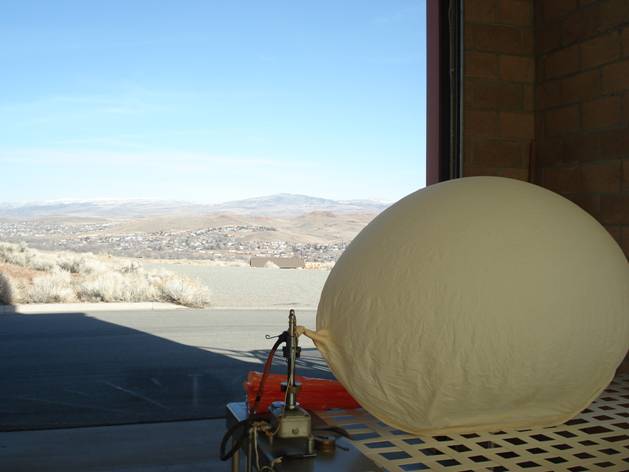
As the balloon is being filled with the desired amount of hydrogen gas, the observer creates the sounding train by measuring the appropriate amount of string, attaching the parachute, and the chemlight or train regulator if necessary. Once the balloon has achieved its desired lift, the flow of hydrogen gas will shut off automatically. Then the observer securely ties off the weather balloon and attaches it to the sounding train. Once all of these steps are completed the weather balloon and sounding train are ready to be launched.
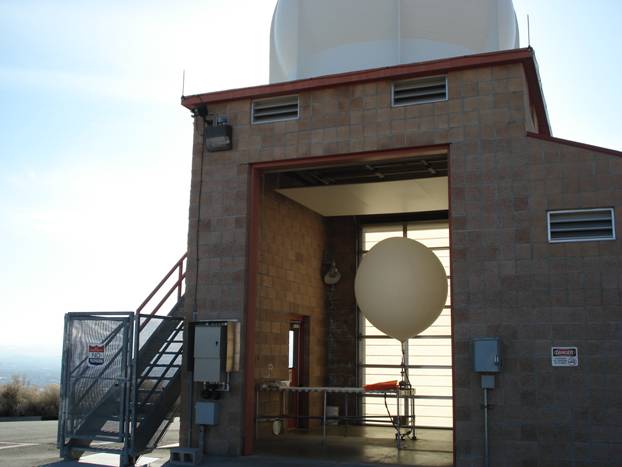
The radiosonde must now be prepared by unpacking and inspecting the instruments sensors and attaching the flight information label. The radiosonde battery is water activated and can power the instrument for up to four hours. Once the battery is activated it is placed into the radiosonde to begin the process of baselining the radiosonde. During the baseline process, the radiosonde is being checked for accuracy and discrepancies and to ensure that the GPS is functioning properly. If the radiosonde does not pass the baseline criteria, it will be rejected and sent back the National Reconditioning Center.
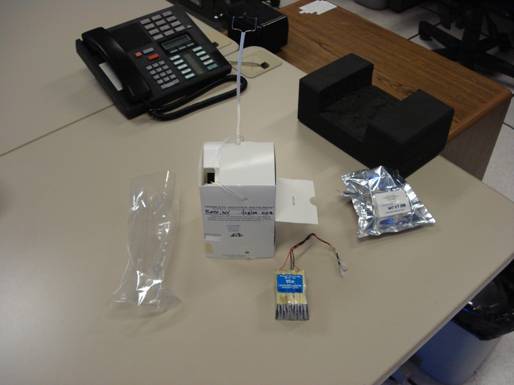
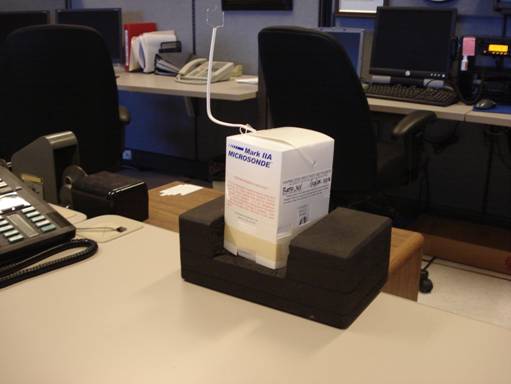

Once the radiosonde has passed through the baseline process successfully and the desired launch window has come (one hour prior to the desired flight time), the radiosonde is taken out to the upper-air building and launch area, and is attached to the sounding train. Since the weather station is located within 5 nautical miles of the Reno-Tahoe International Airport, the observer must call the Federal Aviation Administration (FAA) Control Tower to receive clearance for the launch. On occasion, the observer will be delayed by incoming aircraft to the airport (see picture below).

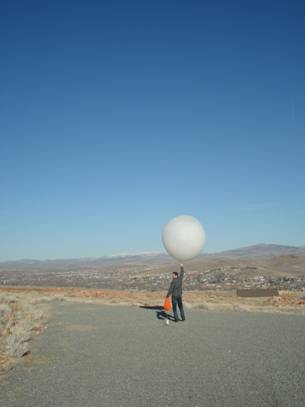
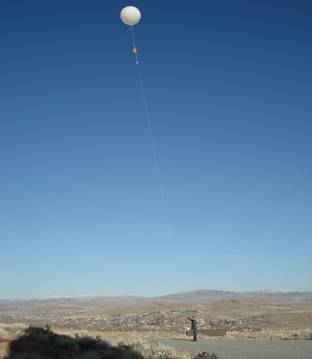 |
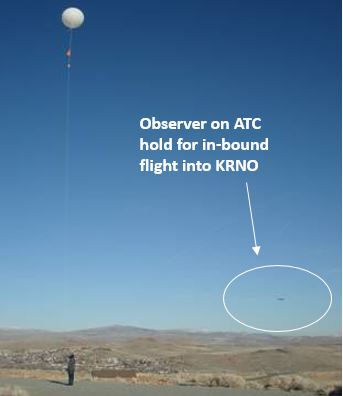 |
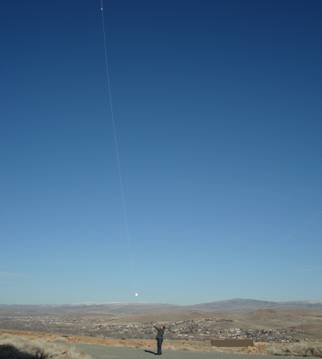 |
 |
After the launch, the observer secures the building and returns to the RRS computer workstation in order to lock onto the balloon. The observer must also quality control the data and fixes any errors that may be present throughout the flight in the sounding. Typical errors that need to be corrected include super adiabatic lapse rates off of the surface and relative humidity errors off of the surface as well. The observer has a number of graphical displays and data readouts at their disposal to quality control the data during the typical 1:45 minute flight. At select intervals throughout the flight, radiosonde data is transmitted to the National Centers for Environmental Prediction (NCEP) to be ingested into the various forecast models. The data is also quality controlled at NCEP as well.
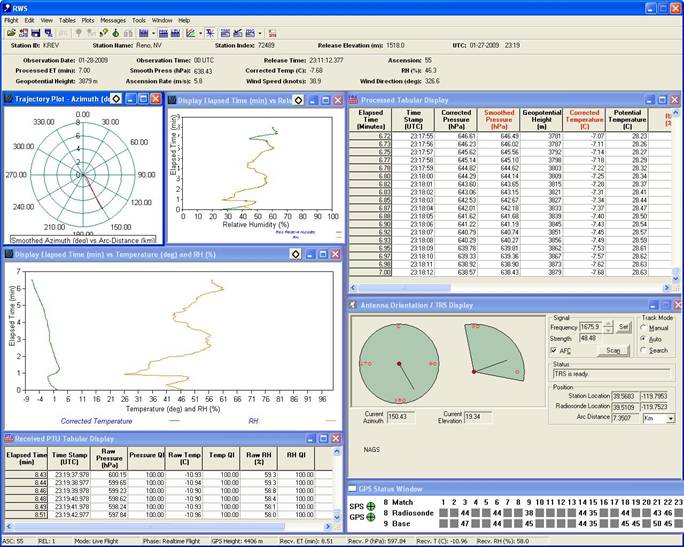
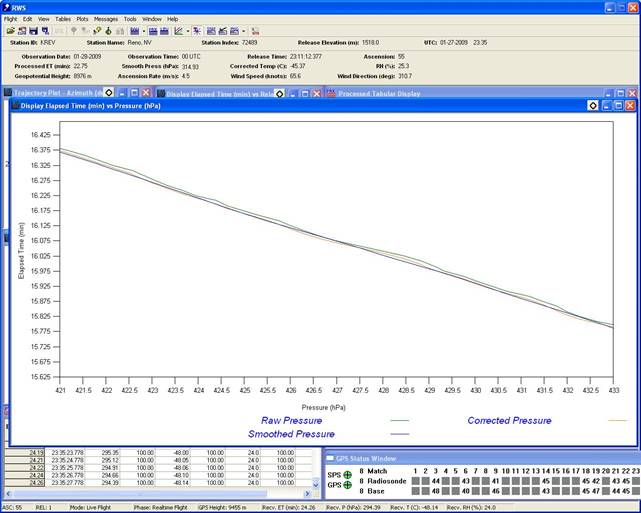
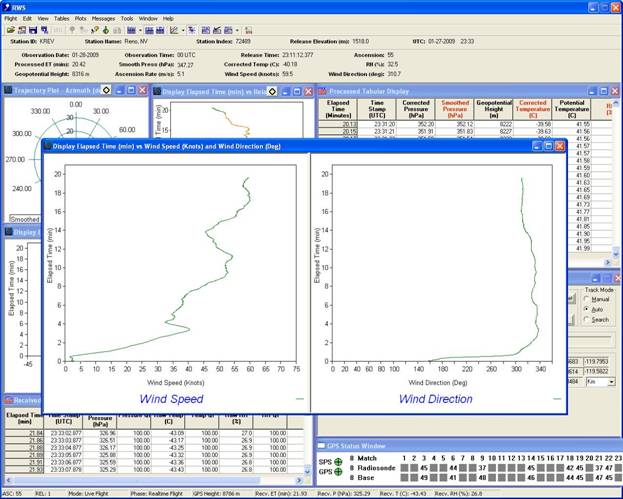
Once the sounding reaches its termination level, typically 90,000 – 100,000 feet as mentioned earlier, the flight is terminated and the remaining data is transmitted to NCEP. The observer collects data from the flight summary screen and uploads the flight data to the National Climate and Data Center (NCDC) for archiving. The flight data is also entered into a standard form which is sent to the National Weather Service Headquarters in the Washington, D.C. area monthly.
Here is sample of the coded messages sent to NCEP and NCDC:
TTBB 80120 72489 00862 00856 11836 01056 22821 00057 33815 00859 44809 01458 55802 02064 66796 02263 77790 02464 88785 02670 99783 02664 11780 02463 22775 02268 33757 01263 44750 02269 55745 02070 66740 02279 77736 02475 88679 01374 99665 01578 11573 09578 22484 20769 33442 25175 44381 34375 55357 36975 66274 51766 77262 53365 88246 57164 99190 68561 11181 68761 22176 69961 33170 68161 44163 70161 55161 69361 66160 67161 77157 67161 88147 63962 99137 65562 11125 62363 22116 63763 33111 62363 44110 62763 31313 58708 81104 41414 00900
The upper-air program remains vital for providing data to a number of entities and agencies. It serves as perhaps an antiquated method for gathering data in view of today’s modern era, but still proves to be quite effective in its mission of sampling the upper atmosphere. Of the approximately 75,000 radiosondes that are released yearly, only about 20% are found and returned for reconditioning. If you happen to be lucky enough to find a radiosonde, follow the directions on the instrument, and use the provided, pre-paid envelope to send the radiosonde back to the National Reconditioning Center.
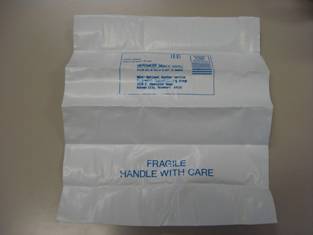
After the last messages are transmitted, all of the computer systems are shutdown, and will remain off until the entire process starts again 12 hours later. One last interesting note...despite all of the differences between people and governments throughout the world, every observer, no matter which continent or country they are from...we all launch our weather balloons at the same time! Thank you for taking the time to view WFO Reno’s Upper-Air virtual tour. For more information, please visit the National Upper-Air Program page. Please send questions or comments to Scott.McGuire@noaa.gov.